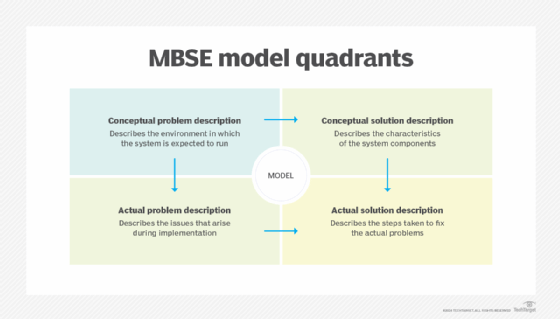model-based systems engineering (MBSE)
What is model-based systems engineering (MBSE)?
Model-based systems engineering (MBSE) uses models to share information across collaborators in the design, development, test and operation of complex systems. These could include physical products, software or infrastructure. MBSE can also help design systems spanning these categories, such as a car and the software it runs.
In some respects, MBSE is comparable to Agile practices in the software development world -- but applied to physical things. It prescribes an approach that requires careful balancing of the best practices, tools and cultural shifts needed to achieve higher maturity levels.
The concept has picked up steam in the systems engineering community building the industrial metaverse to help them link various types of experts and roles across different views of a shared reality. These shared models go beyond 3D representations to include information about the requirements, design, analysis, verification and validation activities associated with a system across its lifecycle.
There are three essential elements of MBSE:
- Models that capture the essence of some elements of various aspects of the system.
- Systems thinking that looks at the context of a system in terms of both the outside world and the interrelation of its parts and subsystems.
- Systems engineering, which is the discipline of designing systems by considering all aspects of their architecture, development, deployment, operation and management.
The overarching model should cover four systems engineering domains: requirements, behavior, architecture and testing. Elements in the model correspond to parts of speech. Nouns correspond to actors, components and requirements. Verbs correspond to functions, operational activities and use cases. Adjectives correspond to attributes and properties, while adverbs describe the relationship between components, including their interfaces and integration points.
MBSE is often contrasted with document-based systems engineering or traditional systems engineering. The key difference is that the system is represented as models rather than documents. Sometimes, data might be stored as text, Excel spreadsheets, 3D engineering models or code. In the MBSE approach, these must be dynamically linked to a system architecture model that maintains the integrity of a holistic system of record. This coherent overarching model is created using one of many systems modeling languages, including Eclipse Capella, IEEE High Level Architecture, ISO Application Protocol 233, Modelica, Systems Modeling Language (SysML), Simulink and Unified Modeling Language (UML).
The models of these different aspects must then be interlinked in a shared repository or decentralized mesh. The high-level view of the model is stored as a system architect model that ensures changes made in one place are automatically propagated across all other views or copies.
What are the 4 quadrants of the MBSE model?
The MBSE modeling approach breaks the characteristics of a project into four quadrants that span a conceptual problem/conceptual solution axis and an actual problem/actual solution axis.
The conceptual problem description characterizes the environment in which the system is expected to run. For example, a car description might state that it meets all highway safety regulations, runs for three years and drives 500 miles without refueling or recharging.
The conceptual solution description describes the characteristics of the system components, such as a battery pack, electric motors and windshield wipers. Changes in the problem can affect the solution. For example, new car regulations or more stringent emissions criteria influence the components chosen and subsystems involved.
As the car is designed and built, new information becomes available as part of the actual problem description and actual solution description. For example, a team might discover that the wipers don't work as intended or that the doors aren't as secure as needed. This, in turn, influences the choice of components and their configuration in the actual car.
In the best case, teams might discover issues through a comprehensive testing approach using digital twins and simulation tools. But, sometimes, new problems aren't realized until after a product is released, which can lead to expensive recalls, workarounds to the existing problem and updates to the design of future models.

Benefits of MBSE
An MBSE practice can achieve many of the same benefits as adopting Agile practices in software development, including the following:
- Faster development cycle.
- Reduction in defects.
- Lower costs.
- Ease of changes.
- Better security.
- Simplified update cycle.
- Improved design reuse.
- Increased customer satisfaction.
Challenges with MBSE
MBSE is a complicated discipline requiring changes across development processes, tools, integration and culture. Some of the biggest challenges are the following:
- Interoperability across tools, particularly those from different vendors.
- Training in a highly technical discipline.
- Cultural silos across the company or organizations involved.
- Pushback against changes in the processes and organizational structure.
- Technical silos across different types of tools.
- Integration complexity across multiple tools.
- Reliably updating models across different parts of the lifecycle.
- Automating the propagation of changes across various tools and artifacts.
MBSE vs. traditional systems engineering
Systems engineering breaks down a complex project into various phases around studying the problem, defining the problem, sketching a solution, adapting the plan in response to new information, ongoing monitoring of the solution during development and, finally, studying the implementation after the system is operational.
Traditional systems engineering creates many paper documents, such as reports, specification sheets, requirements lists, component specifications, engineering drawings and budgets. Changes to any document need to be manually updated across all other documents referencing that one. This doesn't always happen and can result in lost information, confusion and incompatibilities in the final design.
MBSE is a relatively newer discipline. The term was coined in 1993, but some of the practices and ideas date back decades earlier to work on domain-specific modeling, model-driven development and software architecture. In its purest form, MBSE stores all relevant data in the form of interconnected, interlinked models. Changes in any system can then be propagated to other references the system changed. This improves collaboration, streamlines communications and provides greater visibility across all people whose work might be affected by the change.
Examples of MBSE
The following are some examples of how MBSE can be or is used in organizations:
- Helping automotive firms transition to electric vehicles.
- Designing new car charging equipment and supporting infrastructure.
- Designing new medical equipment, tracking quality and making adjustments when required.
- Designing consumer electronics devices and software.
- Reconfiguring factories for new product designs or to reduce defects.
- The U.S. Department of Defense mandates MBSE for all aerospace and defense systems.
- The National Aeronautics and Space Administration extensively uses MBSE to design new spacecraft and support infrastructure.
How to implement MBSE into your organization
MBSE needs to be approached as a long-term project that might take time, money and training to start but can bring significant benefits once the practice takes off. The following tips can help organizations get started:
- Start with a simple project of limited complexity, ideally something new that isn't burdened by too much existing documentation and organizational inertia.
- Invest in training such as the International Council on Systems Engineering (INCOSE) library, certifications and meetings.
- Use MBSE capabilities built into existing tools for product design, simulation and requirements management when available. Otherwise, start with open source tools, such as Eclipse Capella.
- Develop the new project or product from scratch using MBSE, and take notes about what works, problems and solutions.
- After gaining experience in MBSE practices, identify bottlenecks, and explore how additional tools or services might help.
- Evangelize success across the organization to build traction and share lessons.
History of MBSE
MBSE builds on more than 80 years of research and innovation in systems engineering and software development. The following are some of the more significant milestones in its history:
- 1940s. Bell Lab develops a new engineering discipline to solve difficult interconnected problems.
- 1948. Rand Corp. creates systems analysis.
- 1950. G.W. Gilman begins teaching systems engineering at the Massachusetts Institute of Technology.
- 1957. Harry Goode and Robert Machol publish System Engineering: An Introduction to the Design of Large-Scale Systems.
- 1974. Ed Yourdon begins work on what becomes structured analysis, design and programming techniques to transform requirements into code. His organization eventually trains more than 250,000 in the new methods.
- 1980s. Yourdon formalizes his work on structured techniques into the Yourdon Structured Method.
- 1980s. The software industry pioneers computer-aided software engineering tools for model-driven engineering.
- 1990. The National Council on Systems Engineering is founded to create "a better world through a systems approach." It later adds International to its name to become INCOSE.
- 1993. A. Wayne Wymore publishes Model-Based Systems Engineering: An Introduction to the Mathematical Theory of Discrete Systems and to the Tricotyledon Theory of System Design.
- 1996-1997. The UML Partners consortium specifies UML and proposes it to the Object Management Group for standardization.
- 2003. The SysML Partners group develops SysML, which is based on UML.
- 2009. INCOSE publishes Systems Engineering Vision 2020, which lays out a roadmap for the future of MBSE.
- Present. MBSE capabilities are now baked into leading design, engineering, simulation and requirements management tools. Vendors continue to innovate new capabilities and workflows, including adopting generative artificial intelligence to help translate user stories and texts into MBSE-compatible models. Increasingly, the industry is starting to connect MBSE to digital twins that weave a digital thread across more systems in a system's lifecycle to improve information flow.








